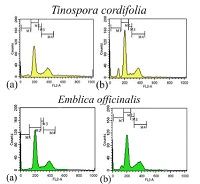In vitro cytotoxic effect of hydroalcoholic extracts of medicinal plants on Ehrlich’s Ascites Carcinoma (EAC)
Keywords:
Medicinal plants, hydroalcoholic extract, EAC, cytotoxicityAbstract
Cancer continues to represent the largest cause of mortality in the world and claims over 6 million lives each year. An extremely promising strategy for cancer prevention today is chemoprevention, which is defined as the use of synthetic or natural agents (alone or in combination) to block the development of cancer in human beings. Plants, vegetables, herbs and spices used in folk and traditional medicine have been accepted currently as one of the main sources of cancer chemopreventive drug discovery. Hydroalcoholic extracts of Terminalia chebula, Terminalia belerica, Emblica officinalis, Caesalpinia crista, Cajanus cajan, and Tinospora cordifolia are found to be variably and selectively cytotoxic to normal and EAC cells. Hydroalcoholic extracts of Terminalia chebula, Terminalia belerica, Emblica officinalis, Caesalpinia crista, Cajanus cajan, and Tinospora cordifolia which have been found to be possible natural antioxidant are evaluated for their selective cytotoxic effect on murine tumor cell Ehrlich’s Ascites Carcinoma (EAC) and normal spleenocyte cell. The extracts were subjected to cytotoxicity test by the tetrazolium cell proliferation reagent (WST-1) assay in vitro. The results showed that the plant extracts were invariably non toxic for the normal spleenocyte cell, whereas they showed toxicity for EAC cells in different degree. The cell cycle analysis for the EAC cells treated with the extracts of the aforesaid plants showed a variable, yet dosedependent increasing percentage of apoptosis. The results signify that the plants which have antioxidant property may function as cytotoxic agent for cancer cell.
References
. Xia M, Wang D, Wang M, Tashiro S,
Onodera S, Minami M, Ikejima T.
Dracorhodin percholarate induces
apoptosis via activation of caspases and
generation of reactive oxygen species. J
Pharmacol Sci. 2004;95:273–283.
. Farnsworth NR, Soejarto DD. Potential
consequences of plant extinction in the
United States on the current and future
availability of prescription on drugs. Econ
Bot. 1985;39: 231.
. Farnsworth NR, Soejarto DD. Global
importance of medicinal plant. In:
Akerele OG et al., editors. Conservation
of Medicinal Plant. Cambridge, UK:
Cambridge University Press; 1991. p. 25.
. Kim JB, Koo HN, Joeng HJ, Lyu YS,
Park SG, Won JH, Kim YK, Hong SH,
Kim HM. Induction of apoptosis by
Korean medicine Gagamwhanglyunhaedoktang through activation
of caspase-3 in human leukemia cell line,
HL-60 cells. J Pharmacol Sci.
;97:138–145.
. Kintzios SE. Terrestrial plant derived
anticancer agents and plants used in
anticancer research. Crit Rev Plant Sci.
;25:79–113.
. Indap MA, Radhika S, Motiwale L, Rao
KVK. Quercetin: antitumour activity and
pharmacological manipulations for
increased therapeutic gains. Indian J
Pharm Sci. 2006;68:465–469.
. Saleem A, Husheem M, Härkönen P,
Pihlaja K. Inhibition of cancer cell growth
by crude extract and the phenolics of
Terminalia chebula retz. fruit. J
Ethnopharmacol. 2002;81:327-336.
. Sandhya T, Lathika KM, Pandey BN,
Mishra KP. Potential of traditional
ayurvedic formulation, Triphala, as a
novel anticancer drug. Cancer Lett.
;231(2):206-14.
. Kaur S, Michael H, Arora S, Härkönen
PL, Kumar S. The in vitro cytotoxic and
apoptotic activity of Triphala—an Indian
herbal drug. J Ethnopharmacol.
;97(1):15-20.
. Hazra B, Sarkar R, Biswas S, Mandal N.
Comparative study of the antioxidant and
reactive oxygen species scavenging
properties in the extracts of the fruits of
Terminalia chebula, Terminalia belerica
and Emblica officinalis. BMC Comp
Altern Med. 2010;10:20.
doi:10.1186/1472-6882-10-20.
. Mandal S, Hazra B, Sarkar R, Biswas S,
Mandal N. Assessment of the Antioxidant
and Reactive Oxygen Species Scavenging
Activity of Methanolic Extract of
Caesalpinia crista Leaf. eCAM.
;Article ID nep072.
doi:10.1155/2009/nep072.
. Khan MI, Harsha PS, Giridhar P,
Ravishankar GA. Pigment identification,
antioxidant activity, and nutrient
composition of Tinospora cordifolia
(willd.) Miers ex Hook. f & Thoms fruit.
Int J Food Sci Nutr. 2011;62(3):239-49.
. Gupta M, Mazumder UK, Sambath
Kumar R, Sivakumar T, Vamsi MLM.
Antitumour activity and antioxidant status
of Caesapinia bonducella against Ehrlich
ascites carcinoma in Swiss albino mice. J
Pharmacol Sci. 2004;94:177–184.
. Jagetia GC, Rao SK. Evaluation of the
antineoplastic activity of guduchi
(Tinospora cordifolia) in Ehrlich ascites
carcinoma bearing mice. Biol Pharm Bull.
;29(3):460-6.
. Sarkar R, Hazra B, Mandal S, Biswas S,
Mandal N. Assessment of in vitro
antioxidant and free radical scavenging
activity of Cajanus cajan. J Comp Int
Med. 2009;6(1):Article 24. doi:
2202/1553-3840.1248.
. Ashidi JS, Houghton PJ, Hylands PJ,
Efferth T. Ethnobotanical survey and
cytotoxicity testing of plants of Southwestern Nigeria used to treat cancer, with
isolation of cytotoxic constituents from
Cajanus cajan Millsp. leaves. J
Ethnopharmacol. 2010;128(2):501-12.
. Luo M, Liu X, Zu Y, Fu Y, Zhang S, Yao
L, Efferth T. Cajanol, a novel anticancer
agent from Pigeonpea [Cajanus cajan (L.)
Millsp.] roots, induces apoptosis in
human breast cancer cells through a ROSmediated mitochondrial pathway. Chem
Biol Interact. 2010;188(1):151-60.
. Newman DJ, Cragg GM, Snader KM. The
influence of natural product upon drug
discovery. Nat Prod Rep. 2003;17:215–
. Rates SM. Plants as source of drugs.
Toxicon. 2001;39:603–613.
. Aoki K, Yamakuni T, Yoshida M,
Ohizumi Y. Ephedorae herba decreases
lipopolysaccharide-induced
cyclooxgenase-2 protein expression and
NF-κB-dependent transcription in C6 rat
glioma cells. J Pharmacol Sci.
;98:327–330.
. Saito SY, Maruyama Y, Kamiyama S,
Nakahata N, Ohizumi Y. Ephedrae herba
in Mao-Bushi-Saishin-to inhibits IgEmediated histamine release and increases
cAMP content in RBL-2H3 cells. J
Pharmacol Sci. 2004;95:41–46.
. Shimizu M, Azuma C, Taniguchi T,
Murayama T. Expression of cytosolic
phospholipase A2α in murine C12 cells, a
variant of L929 cells, induces arachidonic
acid release in response to phorbol
myristate acetate and Ca2+ ionophores,
but not to tumor necrosis factor-α. J
Pharmacol Sci. 2004;96:324–332.
. Kintzios SE. Terrestrial plant derived
anticancer agents and plants used in
anticancer research. Crit Rev Plant Sci.
;25:79–113.



